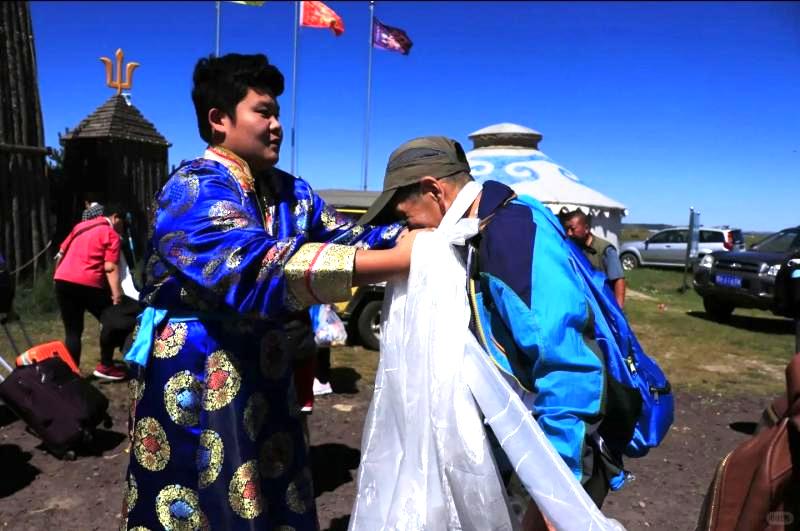“Tibet is not only a land of snow-capped mountains and sparkling lakes but also a sacred plateau rich in culture and faith. Among its unique cultural artifacts is a ceremonial item full of purity and blessings—the Hada.”
A Hada is more than just a piece of cloth; it is a symbol of deep emotion and blessing. For Tibetans, offering a Hada expresses respect, friendship, and good wishes. For travelers, receiving one opens a window into Tibetan culture. The moment you first accept a Hada, you are welcomed into the warmth and generosity of the snow-covered plateau.
Origins and Cultural Significance of the Hada
The history of the Hada dates back to the ancient Tubo Kingdom and became widely used alongside the rise of Tibetan Buddhism. Typically made of silk, cotton, or synthetic fibers, Hadas are long, lightweight, and soft. They are presented in various occasions: welcoming guests, offering to Buddha statues, festivals, weddings, and birthday celebrations.
For Tibetans, the Hada symbolizes purity, auspiciousness, loyalty, and good intentions. Giving a Hada is a way to convey sincere blessings. Within Buddhist belief, the Hada also represents light and wisdom—pure and sacred, like the snow-capped peaks and skies of the plateau.

Colors of the Hada and Their Meanings
While white Hadas are the most common for tourists, Hadas come in multiple colors, each representing the five elements of nature and the “Five Colored Light” concept in Tibetan Buddhism.
- White Hada
Meaning: Purity, kindness, good fortune
Occasions: Welcoming or seeing off guests, offering to Buddha statues
Traveler Experience: Receiving a white Hada is a warm and sincere welcome. - Blue Hada
Meaning: Sky and space, symbolizing vastness
Occasions: Religious ceremonies, expressing reverence
Traveler Experience: In temples or rituals, blue Hadas reflect prayers to the heavens. - Yellow Hada
Meaning: Earth, wisdom, Buddhist teachings
Occasions: Offered to high lamas or Buddha statues
Traveler Experience: Pilgrims present yellow Hadas seeking wisdom and blessings. - Green Hada
Meaning: Rivers, nature, life
Occasions: Symbolizes health, longevity, and prosperity
Traveler Experience: Used in festivals or family events to convey life blessings. - Red Hada
Meaning: Fire, passion, energy
Occasions: Celebrations, weddings, festive occasions
Traveler Experience: Red Hadas at weddings symbolize heartfelt blessings and good fortune.
These five colors correspond to natural elements: white for snow, blue for sky, yellow for earth, green for rivers, and red for fire—reflecting Tibetan reverence for nature and the universe.

Experiencing Hadas as a Traveler
For visitors, Hadas are more than ceremonial cloths—they are a cultural experience.
- Welcoming and Farewell: Tibetans greet guests with Hadas, expressing warmth; when departing, Hadas convey wishes for a safe journey.
- Temples and Pilgrimage: Pilgrims offer Hadas at Buddha statues to pray for wisdom and protection—a direct way for travelers to engage with local religious practices.
- Festivals and Ceremonies: Hadas appear in Tibetan New Year, weddings, and family gatherings, symbolizing emotional bonds and cultural connection.
Proper Etiquette
- Receiving a Hada: Hold it with both hands or bow slightly while expressing gratitude.
- Offering a Hada: Present with both hands or gently drape it over someone’s shoulders.
- In Temples: Place the Hada on the altar or hang it on pillars respectfully.
- Do Not: Discard or step on Hadas, as it is considered disrespectful.

Recommended tourist routes
8-Day Classic Tibet Tour: Lhasa, Everest, Namtso & More $ From 903
Hadas as Travel Souvenirs
Many visitors purchase Hadas as souvenirs. Though inexpensive, they carry profound meaning. They are unique mementos of Tibet and can be given to friends or family as a way to share blessings from your journey.
Hadas embody Tibetan culture and faith. Each color reflects the elements, life, wisdom, and heartfelt wishes. They are more than decorative cloths—they are bridges of emotion and culture.
When you walk before the Potala Palace, receive a white Hada by Namtso Lake, or offer a yellow Hada in a temple, you realize Tibet’s charm is not only in its scenery but also in its deep cultural resonance. Next time you visit the high plateau, notice the Hadas fluttering in the wind—they quietly tell the story of Tibet’s warmth and blessings.












